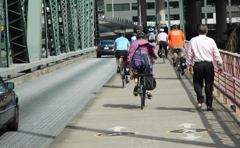So far, in our coverage of the Hawthorne Bridge Crash, we’ve heard from an eyewitness and the two people who collided. We’ve also discussed both infrastructure and behavior-based solutions.
But one important party to this issue has been left out: pedestrians.
It’s hard to determine what exactly caused Erica Rothman’s harrowing crash, but it’s likely that the presence of people on foot played a role (Rothman had veered to the left to avoid them). On that note, I’d like to share an idea from Ron Richings. (Richings is the guy I mentioned in my editorial on Tuesday who put quite a bit of thought and advocacy work into this issue last summer.)
“…during rush hours, all pedestrians could be directed to the south sidewalk in the morning and the north sidewalk in the afternoon.”
— Ron Richings
Richings’ idea is based on the premise that people are quite unpredictable when walking, and keeping them away from bikes would increase safety for everyone. In an email to Multnomah County Transportation Planner last summer, he explained his idea like this (emphasis mine):
“Pedestrians however may walk three or more abreast, turn around without warning, stick out an arm leg or whatever, and do a variety of other unpredictable things. And the closing speed between bikes and pedestrians is much greater than between bikes and bikes, so reaction time can be very limited.
Where all this leads is to wonder if, during rush hours, all pedestrians could be directed to the south sidewalk in the morning and the north sidewalk in the afternoon? A slight inconvenience for walkers but potentially a significant increase in safety and utility for cyclists.”
The idea is to reserve the bridge pathway exclusively for bikes in the prime commute direction.

Richings thinks this would not only help cyclists’ plight, but that the “pedestrian re-allocation” would improve their safety as well. He acknowledges that there might be some “initial grumbling” about being re-routed, but that people would quickly adapt. He also points out that there is some very recent precedent for this in his hometown of Vancouver, B.C..
Faced with dangerously narrow, six-foot wide sidewalks shared between bikes and peds (Hawthorne path is 11-feet wide) on each side of the Burrard St. Bridge, the City of Vancouver decided just last week to do a trial of a new configuration: pedestrians and bikes will now each get their own sidewalk (and bikes also get a full lane on the bridge roadway, something that Multnomah County says won’t happen here).

(Graphic: City of Vancouver)
When I brought Richings’ idea up to a planner friend the other night, he said the idea was worth some thought. The biggest push-back he said it might encounter would be from pedestrian advocates who are loathe to endorse anything that creates any level of inconvenience for walkers (can’t blame them for that).
What do you think? The County is looking for suggestions, so perhaps we can help them vet this one out.


